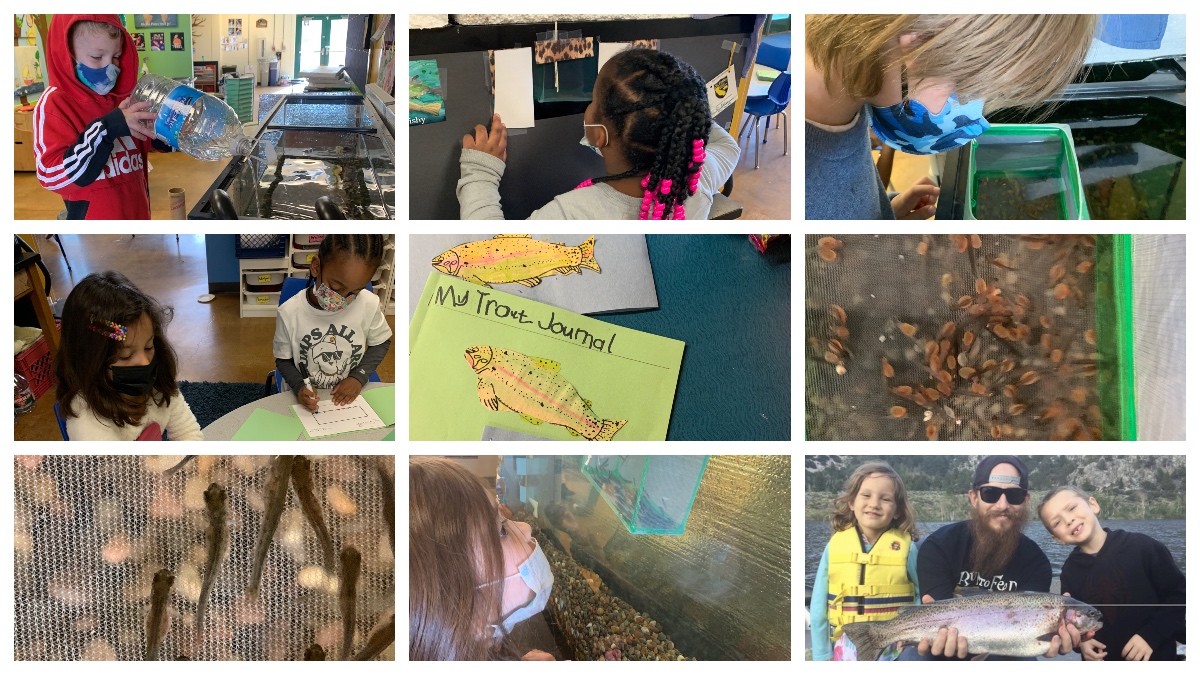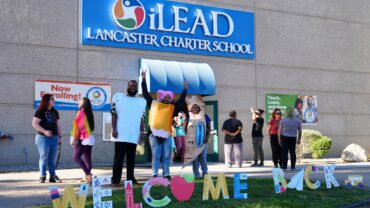Trout Project Teaches Kindergarteners Conservation, Preservation

Young people are more and more taking an active role in advocating for our planet in the form of addressing issues like climate change, animal species protection and saving our oceans. Indeed, the United Nations’ Sustainable Development Goals have several goals aimed at addressing problems related to the future of our planet’s health. Kindergarteners at iLEAD Lancaster are getting a head start here thanks to an ongoing project implemented by their facilitator Kim Lengning.
For several years, Lengning has been implementing the Trout in the Classroom Project – part of an educational program from the California Department of Fish and Wildlife.
Lengning challenges the learners with their driving question: How does learning about trout help me understand the needs of other living creatures and the importance of conservation?
The objective, according to Lengning, is for children to raise trout from eggs to fingerlings, to observe and document changes and to understand how trout grow and develop.
“The intent is to help these young learners understand the value of our natural resources, while integrating learning standards,” said Lengning.
The project is always of high interest and immediately resonates with her learners, according to Lengning.
“Growth and change are something they witness in their own lives,” she said. “Recognizing this same thing in trout can be a huge connection that will begin building foundational knowledge for future learning.”
Lengning first launched the project in 2011 after learning about this type of work from her son who works for the Department of Fish and Wildlife. She admits there was a steep learning curve initially about optimal tank conditions, filter/chiller monitoring and the rules and regulations regarding the possession and handling of game fish.
“Initially, we discovered that the tank was too deep for the learners to adequately view the fish and the filter intake kept sucking up the little fry,” said Lengning. “Out of 100 eggs, we only ended up releasing 12.”
At the end of this project, Lengning said she and the learners must release the fry into a DFW – approved waterway.
“For our community, this is the upper lake of Castaic Lake,” she said.
In this project, earners create several visual artifacts. Emphasized are the importance of observation, documentation, making scientific drawings and discussing all of this information with others.
“These types of projects and experiences are what helps all young learners begin to make sense of the world around them,” said Lengning.
Throughout this entire project, Lengning is helping the learners build content-area vocabulary, knowledge and skills that will be utilized in future projects.
“This project connects to our recycling work, composting and the body parts of other animals,” said Lengning. “It’s all about connecting to the world around us and continually addressing the theme of growth and change.”
Deliverables include an observation journal, a menu of the trout’s diet, a scientifically-labeled drawing, a 3-D art project, a fish biologist badge, a paper bag vest and even a fishing rod in the makery.
“Normally, our Presentation Of Learning is featured near the tank and all of the learners share their various artifacts and overall learning,” said Lengning.
The Trout in the Classroom Project has spawned another annual project for Lengning and her learners. This is the annual ‘Everything Grows’ Project where learners hatch chicks and ducklings.
Lengning said other facilitators could build on this project in later years. For example, she said that middle school learners could focus on water testing and analysis, access to clean water and other projects related to conservation and preservation.
Feedback on this project – from learners, parents and community partners – has been very positive. Lengning said her learners are engaged and parents are always positive about their learners’ experiences with this project. She said she also enjoys the partnership with the Department of Fish and Wildlife.
California Department of Fish & Wildlife’s Jennifer O’Brien has coordinated the Trout in the Classroom Project with Lengning for several years. O’Brien – who is a liaison between the classroom facilitators, the sponsors, hatchery personnel and biologists – said that this project is important because it helps learners understand the value of aquatic environments.
“These young learners begin to appreciate the need to maintain, protect and enhance California’s fisheries and aquatic habitats,” said O’Brien. “We as humans have a profound impact on these valuable resources and we need to instill a sense of awareness and personal responsibility for aquatic organisms and the state’s ecosystems.”
O’Brien has been nothing less than overwhelmed by Lengining’s dedication to this project and the work with her young learners.
“Kim has been involved with Trout in the Classroom for many years and has brought much passion and excitement directly into her classroom,” she said. “The students are lucky to have such a dedicated facilitator.”
For Lengning, this type of project is all about engaging learners with authentic science experiences. She said she’s excited and engaged and therefore so are the learners.
“Because I love the project, I am able to facilitate and keep the learners’ interests most of the time,” she said. “I have officially become a trout nerd.”
(Note: check out this unedited video where Kim Lengning showcases this project)
RECENT POSTS

2025 School Year Begins Soon! Key Dates and Information
Dear iLEAD Lancaster Families, We hope that you have been enjoying the summer and have made many happy memories. We are looking forward to having all of our returning and… Read more

Middle School Orientation: August 8
Middle School Orientation is Friday, August 8, from 4:00 to 5:30 PM. Parents of incoming 6th-8th graders, please join us at iLEAD Lancaster (254 E. Ave. K4, Lancaster) to get… Read more

Dragons Spirit Squad at Solé of the Community Backpack Giveaway: August 9
The iLEAD Lancaster Dragons Spirit Squad will be at the Antelope Valley Mall on August 9, 2025, from 11:00 AM to 3:00 PM, joining Solé of the Community for a… Read more


